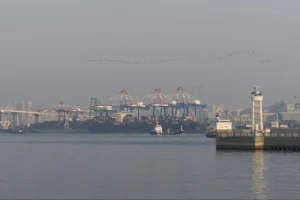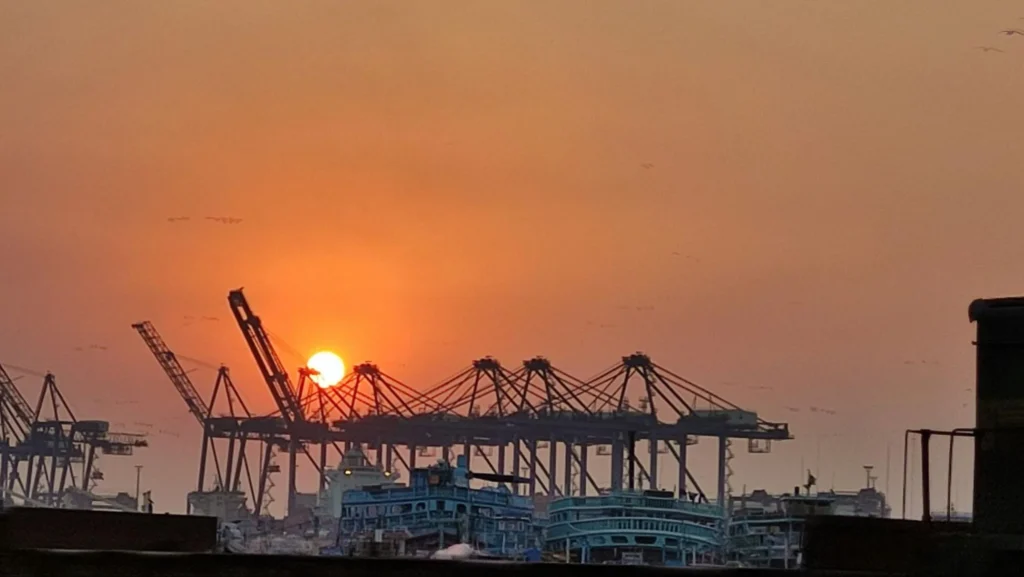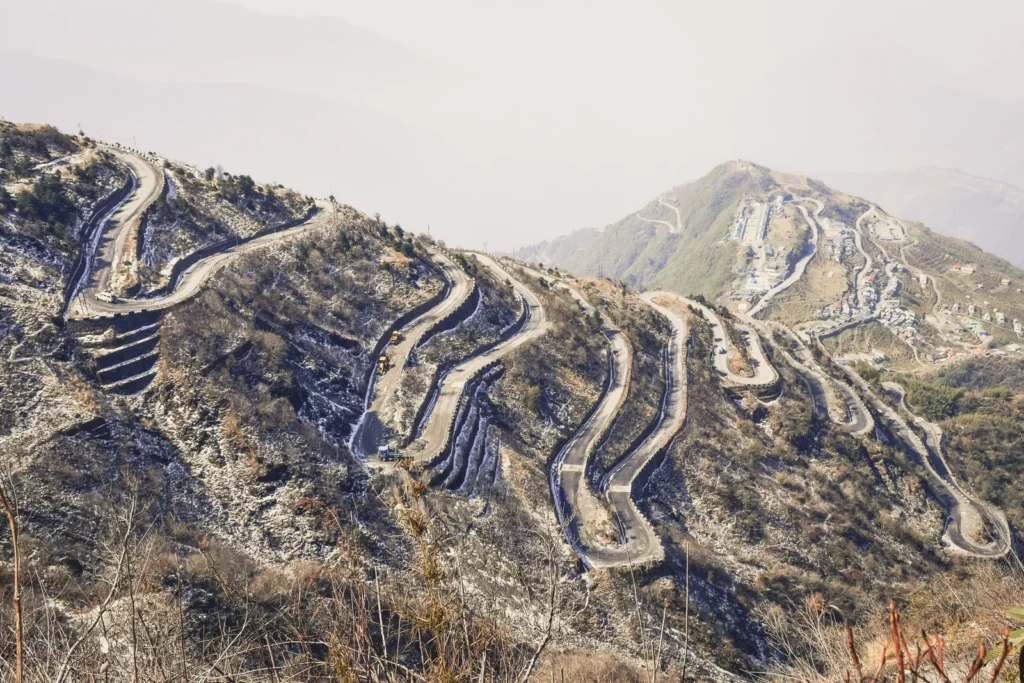CONTENT

By: Ashley Dudarenok
Updated:
The term “String of Pearls” was coined by American consultancy Booz Allen Hamilton in a 2005 report. Western analysts employed the metaphor to describe a perceived Chinese plan to acquire a chain of overseas port facilities spanning from the South China Sea to the Suez Canal, thereby enabling Beijing to project its naval power across the Indian Ocean and protect its energy supply lines.
Yet, academic analysis shows that there is little evidence to suggest that China intends to militarize this network; the so-called pearls are predominantly commercial ports and logistics hubs that support energy security and trade.
Energy security does matter — 80 percent of China’s crude imports pass through the Malacca Strait — but the evidence points to a pragmatic strategy aimed at reducing dependence on a single chokepoint rather than a covert naval expansion.
This article revisits the debate in 2025-26, drawing on high‑authority sources from China and abroad to assess how Beijing’s maritime reach and economic clusters have evolved.

Booz Allen’s report suggested that China was building or funding ports in Gwadar (Pakistan), Hambantota (Sri Lanka), Chittagong (Bangladesh), Kyaukphyu (Myanmar), and other locations as part of a strategic “pearl necklace.” In subsequent years, this narrative gained widespread circulation in Western media and defense circles.
According to a 2011 analysis, however, the string-of-pearls frame is essentially a myth. Most of the ports in question remain under host‑country control and are utilized for commercial shipping; there is no evidence of Chinese listening posts or permanent naval deployments. Beijing’s primary motivation has been to secure stable energy corridors and diversify trade routes, rather than establishing a network of overseas bases.
China occasionally docks naval vessels at partner ports or sends security personnel to protect assets in conflict zones, but these deployments are limited. At Myanmar’s Kyaukphyu port, for example, media reports indicate that approximately 50 Chinese security personnel are stationed there. Chinese analysts emphasize that local governments retain sovereignty and that Beijing’s involvement is strictly limited to the economy.
Understanding this nuance is essential: the “pearls” support China’s commercial and energy interests, but they also serve the development agendas of host countries.
China imports around 75 percent of its crude oil and relies heavily on shipping through the Strait of Malacca. Any disruption in this narrow waterway would have serious economic consequences. Ports along alternative routes offer strategic redundancy.
Gwadar in Pakistan is situated near the entrance to the Strait of Hormuz. At the same time, Kyaukphyu is linked to pipelines that traverse Myanmar, delivering oil and gas directly to China’s Yunnan province.
By diversifying routes, Beijing reduces vulnerability to blockade or conflict in Southeast Asia. Building a broad portfolio of port access agreements is not inherently militaristic; it reflects the logic of supply‑chain risk management.

Gwadar epitomizes the transformation of China‑funded ports. A decade ago, the port was a modest fishing harbor. Under the China–Pakistan Economic Corridor (CPEC), it has been expanded into a modern logistics hub with three multipurpose berths capable of handling vessels weighing up to 50,000 tons, as well as processing containers, bulk cargo, and vehicles.
Supporting infrastructure has followed: the East Bay Expressway, opened in 2022, links the port to Pakistan’s highway network, while a new international airport opened in January 2025. A free‑trade zone offers tax incentives to attract manufacturing and logistics firms.
Pakistan’s government intends to route 60 percent of its official imports and exports through Gwadar, aiming to increase the shipping industry’s contribution to the country’s GDP to 5 percent. Officials have described Gwadar as poised to become a world‑class port and catalyst for economic transformation.
CPEC’s second phase, launched in 2024, shifts focus from infrastructure to industrial cooperation and the digital economy. An October 2025 report notes that 43 projects worth approximately US$25 billion were completed in the first phase, including 17 energy projects that added 8,800 MW of capacity and eight transport projects covering 888 km of highways.
The new phase emphasizes agriculture, minerals, technology, and green growth; a proposed mineral corridor would link Gwadar to resource‑rich Balochistan. The aim is to attract private investment rather than rely solely on state‑led funding. In this sense, Gwadar’s evolution demonstrates Beijing’s move from building infrastructure “pearls” to fostering industrial clusters along the corridor.
Sri Lanka’s Hambantota International Port has often been portrayed as a cautionary tale of “debt‑trap diplomacy.” In reality, the port’s growth is rooted in commercial cooperation. According to news, the port recorded a 22 percent growth in cargo throughput in 2024 and plans further expansion with the addition of new gantry and yard cranes to increase capacity in 2025.
Another report notes that Hambantota saw 40 percent throughput growth in the first eight months of 2024 and is expected to reach 50 percent by year‑end. General Manager Shi Muyong attributed the success to the port’s strategic location on the busy east-west shipping lanes and its efficient services. Growth was robust in bulk cargo, liquefied gas, and container segments.
The port’s potential is attracting related industries. Sri Lanka has approved a US$3.7 billion refinery by China’s Sinopec near Hambantota, which is expected to process 200,000 barrels per day upon completion. The project, announced in 2023, underscores the port’s role in regional energy supply chains.
Sri Lanka’s energy minister emphasized that the island nation’s strategic position on major sea routes gives it leverage and that the government is negotiating for Sinopec to expand its fuel sales domestically. Such investments suggest that Hambantota is becoming a logistics‑industry cluster, not just a transshipment point.
Myanmar’s Kyaukphyu port and special economic zone, co‑developed by China’s state‑owned CITIC Group, provides an alternative route for oil and gas imports. The port is linked by twin pipelines to Yunnan Province, supplying China with direct access to the Indian Ocean and bypassing the Malacca Strait.
However, the project is located in Rakhine State, where the Arakan Army insurgency poses a threat to stability. CITIC executives met with Myanmar’s junta to urge the acceleration of the project, discussing environmental and social impact studies and security concerns. It stresses that progress remains slow because the proposed road and rail links traverse rebel‑held territory.
Analysts suggest that Beijing is keen to protect its investments and may accept temporary control of the port by local forces, as long as pipelines and assets remain secure. Kyaukphyu highlights the complexities of operating in conflict zones and underscores the importance of diplomatic engagement.
Bangladesh has emerged as a manufacturing hub for Chinese firms seeking to diversify away from higher tariffs in the United States. Its main ports, Chattogram and Mongla, have attracted Chinese investment.
A research suggests that China pledged US$400 million to modernize Mongla port and that Chinese naval vessels made a goodwill visit to Chattogram in October 2024. It argues that debt financing could create leverage for China, but this view remains speculative.
Bangladesh’s government, facing economic challenges, has invited Chinese companies to invest in infrastructure, renewable energy, and trade. While strategic competition with India is real, these projects are primarily economic, aimed at improving port efficiency and attracting industry, rather than establishing naval outposts.
China’s maritime influence now extends beyond South Asia into Africa. One highlight is Cameroon’s Kribi Deep Seaport, built by China Harbor Engineering Company (CHEC). In May 2025, Cameroonian authorities inaugurated the port’s second phase. The port can now dock 100,000‑ton ships—ten times larger than what Douala port could handle—and has an annual handling capacity of 4.5 million tons.
Cargo throughput has grown by an average of 22 percent annually, attracting more than 60 companies and creating over 6,000 jobs. Nearby, a ceramics factory can ship products to neighboring countries within 48 hours, exemplifying the integration of the port industry.
Nigeria’s Lekki Port, also built by CHEC, is part of a larger Lekki Free Trade Zone. The zone’s design capacity of 1.2 million TEUs per year and US$2.3 billion investment support local appliance and automotive manufacturing.
According to CHEC executive Chen Ze, coordinated development of ports and industrial parks is key to transforming transient flows into “lasting settlements,” allowing African goods to be produced locally and sold globally.
Since the inception of the Forum on China‑Africa Cooperation (FOCAC) 25 years ago, Chinese firms have built or upgraded over 100 ports, along with 10,000 km of railways and nearly 100,000 km of roads. These projects integrate African economies into regional and global trade networks, reflecting Beijing’s broader maritime outreach.
China is also building direct shipping links from its own provinces to African destinations. In September 2025, Jiaxing Port in Zhejiang Province launched its first direct route to Africa, with a Hong Kong-registered bulk carrier sailing to Zanzibar and Beira carrying 200 TEUs of infrastructure materials.
Local authorities expect the monthly service to reduce logistics costs and foster deeper economic cooperation between the Yangtze River Delta and countries along the Belt and Road Initiative. Although far from the Indian Ocean’s choke points, this route illustrates how Chinese coastal ports are connecting to the maritime “pearls” via long‑distance trade corridors.
The Guangdong–Hong Kong–Macao Greater Bay Area (GBA) comprises 11 cities, including Hong Kong, Macau, Shenzhen, Guangzhou, and Zhuhai. The region’s economic output reached 14 trillion yuan (US$1.95 trillion) in 2023, making it a dynamic growth engine and demonstrating China’s “new quality productive forces”.
The GBA is strategically positioned at the mouth of the Pearl River Delta, one of China’s most export‑oriented manufacturing hubs. Its success hinges on cross‑border integration:
The Shenzhen–Hong Kong–Guangzhou cluster is recognized globally for innovation. In the 2025 Global Innovation Index, the World Intellectual Property Organization (WIPO) ranked this cluster first worldwide, surpassing Silicon Valley.
Hong Kong officials attribute the ranking to a combination of patent filings, scientific publications, and thriving venture‑capital activities. The award reflects collaborative ecosystems across the GBA: Shenzhen’s technology giants (Huawei, DJI, BYD), Hong Kong’s universities and financial markets, and Guangzhou’s manufacturing base.
The Hong Kong government aims to deepen cooperation with Shenzhen in the Hetao Innovation Cooperation Zone, expand cross-border R&D funding, and facilitate the flow of open data. The cluster’s global stature underscores how the GBA functions as an innovation “pearl” within China’s broader maritime network.
Guangdong province has mapped out 20 strategic industry clusters to drive economic leadership, including 10 pillar industries
and 10 emerging industries
The clusters accounted for 40 percent of Guangdong’s GDP in 2023, with their added value increasing by 5.2 percent year-over-year. Revenue from the 10 emerging clusters alone reached nearly 3 trillion yuan, representing a 9.2 percent growth, which is approximately twice the province’s overall GDP growth.
One standout is the biopharmaceutical and healthcare cluster. A provincial plan encompasses 38 tasks aimed at fostering innovation, product upgrading, and commercialization. Officials aim to push output beyond 1 trillion yuan by 2027. The cluster generated 663.8 billion yuan in operating revenue in 2023 and boasts the largest scale of medical device production in China.
The GBA is building a diversified industrial ecosystem that drives China’s move toward high-tech manufacturing and green growth. It works alongside major clusters in new energy vehicles, semiconductors, advanced materials, and digital creativity.

Nansha Port, part of Guangzhou Port, illustrates how GBA infrastructure underpins regional and global trade. In 2024, Nansha’s container throughput reached 20 million TEUs, cementing its status as an international shipping hub.
The port’s foreign trade container throughput exceeded 10 million TEUs for the first time, and foreign trade containers accounted for about half of total throughput—a rare ratio among global ports. Nansha offers 200 container liner routes, including 165 foreign trade routes that connect to Europe, North America, Asia, Africa, and Latin America.
Nearly 150 routes serve Belt and Road countries, and almost 100 routes cater to members of the Regional Comprehensive Economic Partnership (RCEP).
Phase IV of its terminal is fully automated, utilizing smart loading equipment and digital control systems; additional phases and multi-purpose berths are currently under construction. As the only deepwater port in the Pearl River Delta, Nansha enables large vessels to dock directly, thereby reducing logistics costs for exporters.
Nansha’s success demonstrates the synergy between ports and industrial clusters: manufacturers in Guangzhou, Shenzhen, and Foshan can quickly and at a lower cost send goods to global markets, while the port’s connectivity attracts foreign investment.
According to an industry executive, Nansha’s deepwater access and automated terminals make it an ideal base for domestic appliance manufacturers to export to Belt and Road markets. The port is thus a key “pearl” on China’s maritime chain linking domestic production to the global network.
China’s shift toward high‑tech manufacturing requires stable inputs—energy, minerals, and components—and reliable export channels. The maritime network supports both. Oil and gas pipelines from Kyaukphyu reduce energy transit risks for GBA’s factories; Gwadar’s future mineral corridor could channel copper, rare earths, and other resources to Chinese processors.
Hambantota’s refinery will supply fuel for industry and shipping. In Africa, ports like Kribi and Lekki export iron ore, cocoa, ceramics, and electronics; these commodities feed Chinese factories or open markets for Chinese products.
The Jiaxing–Zanzibar route demonstrates how Chinese coastal ports are establishing direct links with African infrastructure projects, facilitating two-way flows of equipment and goods.
For the GBA, these supply routes reduce vulnerability to geopolitical shocks. If the Malacca Strait were disrupted, energy and raw materials could still enter via Gwadar or Kyaukphyu. Meanwhile, Nansha and other ports in the Pearl River Delta ensure that GBA exports reach global markets efficiently.
In this sense, the string‑of‑pearls network complements the region’s industrial clusters by mitigating bottlenecks and diversifying logistics channels.
Chinese planners are increasingly pairing ports with industrial parks and free zones to create ecosystems where goods are produced, processed, and shipped on-site. Gwadar’s free zone has attracted logistics companies and light manufacturing.
Hambantota hosts an industrial park and will be linked to the Sinopec refinery. In Cameroon, the growth of the Kribi port has been accompanied by investments in a ceramics factory and other industries, with port-industry-urban integration becoming a model for Africa.
Similarly, Lekki Port is integrated with a free trade zone, enabling local manufacturers of appliances and automobiles. These examples demonstrate that China’s overseas ports are not isolated naval outposts; they are nodes in supply chains that connect raw materials, processing facilities, and consumer markets.
Within China, the GBA exemplifies this integration. Nansha port sits adjacent to the Nansha Free Trade Zone, which hosts advanced manufacturing, biotechnology, and financial services.
Guangdong’s strategic industry clusters are linked to dedicated industrial parks, such as the Shenzhen International Biotech Park and the Guangzhou Nansha New Area. The synergy between port logistics and industrial production reduces transport costs and encourages innovation. As a result, GBA firms can respond quickly to global demand and supply chain disruptions.
Ports do more than move cargo; they enable the movement of ideas and talent. The GBA’s innovation ecosystem thrives on cross-border mobility: scientists from Hong Kong collaborate with engineers in Shenzhen, while venture capital flows across the border.
Nansha’s logistics infrastructure supports the export of high‑tech products produced in the nearby Hengqin and Qianhai zones. Meanwhile, China’s Africa outreach now includes vocational training.
Angola‑China Institute of Technology and Luban Workshops have trained thousands of African students in mechatronics and engineering. These programs produce skilled workers who can operate and maintain ports, factories, and renewable energy installations, thereby reinforcing the port industry model.
China’s maritime expansion is increasingly oriented toward green energy and digital logistics. The Power Construction Corporation of China constructed the Kabwe 100 MW solar project in Zambia. It is expected to generate about 180 million kWh annually, supplying electricity to nearly 100,000 households.
Such projects supply clean electricity for local industry and reduce reliance on fossil fuels. Digital technologies also play a role: Nansha’s automated terminals use smart dispatching, and Gwadar’s new airport is designed to handle modern logistics.
Industrial clusters in the GBA focus on new energy, energy storage, and smart robots. As China’s Belt and Road strategy evolves, these elements indicate a shift from heavy infrastructure to sustainable and innovative development.
The evidence reviewed above suggests that the string‑of‑pearls label oversimplifies a complex network of infrastructure, trade, and cooperation. China’s overseas ports are primarily commercial logistics hubs with co‑located industrial parks and free zones.
Host countries maintain sovereignty and often invite Chinese investment to spur development. While some Western analysts worry about debt dependency or naval ambitions, the accessible data show that these projects generate tangible economic benefits: jobs, industrial diversification, improved trade capacity, and energy security. There is currently no public evidence that China has converted these facilities into permanent naval bases.
Nevertheless, geopolitical concerns cannot be dismissed. The presence of Chinese security personnel at Kyaukphyu and the Sinopec refinery at Hambantota reflects Beijing’s desire to protect strategic assets. Rising competition with India in Sri Lanka and Bangladesh adds complexity.
Furthermore, the risk of debt distress or transparency issues persists in some host countries. China has begun to emphasize local partnerships, environmental and social impact assessments, and private investment. These measures aim to mitigate risks in the second phase of CPEC and other BRI projects.
Encouragingly, BRI engagement in 2024 exceeded US$70 billion in construction contracts, showing sustained demand despite global uncertainties. Future success will depend on aligning projects with local development plans, ensuring debt sustainability, and promoting inclusive growth.
Two decades after the “String of Pearls” idea emerged, China’s maritime strategy has evolved into a network of commercial, industrial, and digital hubs. Ports like Gwadar, Hambantota, and Kyaukphyu now anchor trade corridors and green industries rather than military bases.
Meanwhile, the Greater Bay Area drives innovation, linking advanced manufacturing and port logistics worth trillions of yuan.
Together, these systems form a mutually reinforcing model: maritime reach powers industrial growth, and industrial clusters strengthen global trade routes. In 2025, China’s strategy reflects pragmatism, integration, and technological progress more than geopolitical rivalry.
The focus ahead lies in assessing its economic impact, sustainability, and governance. China is reshaping global connectivity through infrastructure, innovation, and cooperation.

China’s maritime expansion, GBA innovation, and industrial clustering are transforming global trade. ChoZan’s China Learning Expeditions offer leaders firsthand access to the ports, logistics hubs, and manufacturing ecosystems that are driving this shift.
Through curated visits and strategy workshops in Shenzhen, Guangzhou, and Zhuhai, executives learn how China integrates technology, policy, and infrastructure to strengthen global supply chains. ChoZan’s China Research and Foresighting services further decode policy directions, industrial patterns, and innovation strategies that shape China’s maritime and economic reach.
For companies seeking to understand or align with China’s evolving trade logic, ChoZan offers data-driven insight and on-the-ground experience—turning complex systems into clear strategy.
Learn more or contact the team at www.chozan.co to explore tailored research or a customized China Learning Expedition.
The term once implied a chain of military bases, but by 2025, it had largely been reinterpreted as a commercial and logistics network. Chinese scholars emphasize sustainable connectivity—integrating port economies, digital trade corridors, and industrial parks—rather than territorial projection. The strategy now aligns with the Belt and Road goals on green shipping and supply chain resilience.
China’s focus has shifted toward diversification rather than dominance. LNG and oil terminals across the Indian Ocean and Africa are operated through joint ventures that reduce dependency on a single passage. Beijing also invests in maritime insurance, digital tracking, and strategic storage facilities that stabilize imports without overt militarization.
Most regional governments strike a balance between cooperation and caution. They welcome Chinese port investment for jobs and trade, but increasingly demand transparent financing and local participation. Projects in Malaysia, Indonesia, and Thailand now include clauses on technology transfer, carbon neutrality, and regional workforce development—indicating lessons learned from earlier BRI negotiations.
Green port design has become a diplomatic asset. China’s state-owned enterprises are deploying electric cranes, shore-to-ship power, and AI-based emissions monitoring systems. Ports in Pakistan and Sri Lanka are piloting solar microgrids, aligning with China’s “Blue Partnership” maritime ecology agenda and helping recipient nations meet sustainability pledges under IMO decarbonization frameworks.
Beyond state players, logistics giants such as COSCO and Alibaba’s Cainiao shape digital trade routes through smart port systems and customs automation. Private capital now co-owns bonded warehouses, e-commerce zones, and fintech platforms that process cross-border payments, transforming maritime nodes into data-driven trade ecosystems rather than purely physical supply routes.
African ports anchor China’s “two-ocean” ambition linking the Indian and Atlantic Oceans. Kenya’s Lamu, Tanzania’s Bagamoyo, and Djibouti’s terminals connect inland transport corridors and resource projects. They also act as logistics bases for Chinese manufacturing relocating from Asia to Africa, enabling low-cost exports to Europe under new trade preferences.
The naval component remains minimal and service-oriented. Facilities such as Djibouti focus on escort missions, humanitarian support, and anti-piracy coordination with international partners. Most maritime assets abroad operate under civilian management, separating defense supply lines from the revenue-generating port concessions run by Chinese shipping conglomerates.
China’s digital silk routes now overlay its sea routes. Undersea cables, satellite navigation, and blockchain customs systems create synchronized logistics data across ports. These networks reduce clearance delays and enhance cargo security, enabling China’s fintech firms to handle settlement and insurance for global trade clients in real-time.
Shenzhen and Guangzhou export smart-port technologies and autonomous vessel systems used in Southeast Asia. Their start-ups collaborate with maritime universities and shipyards in Zhuhai to design electric ferries and hydrogen-powered cargo ships. The GBA’s tech ecosystem thus converts innovation capacity into exportable marine hardware and software.
Clusters in new-energy vehicles, electronics, and chemicals rely on predictable shipping schedules. Chinese ports abroad offer “last-mile” access to regional value chains, enabling GBA suppliers to store, assemble, or customize goods closer to their customers. This global distribution footprint shortens delivery times and raises the competitiveness of China-based manufacturers.
Cross-border settlements at Chinese-operated ports increasingly use the digital yuan. Pilot programs in the UAE, Malaysia, and Singapore demonstrate real-time currency exchange between trading partners. This system reduces transaction costs, strengthens financial transparency, and advances Beijing’s long-term objective of promoting RMB usage in global commodity trade.
Yes. The pandemic revealed the fragility of long shipping chains. Since 2022, China has emphasized redundancy by creating parallel trade corridors through ASEAN and the Middle East. The String of Pearls network now serves as a strategic reserve route for essential materials, including semiconductors, EV batteries, and critical minerals.
Social responsibility programs have expanded significantly. Chinese contractors now fund vocational schools, coastal conservation efforts, and small-business credit lines near their project zones. In Pakistan and Myanmar, port-linked economic zones include housing and medical facilities for local workers, addressing earlier criticisms of limited local benefit.
Perception management remains difficult. While China frames its approach as cooperative development, Western policymakers often interpret it through a security lens. Beijing counters through multilateral forums—offering open port access, debt-relief restructuring, and joint research on maritime safety—to differentiate its economic diplomacy from power projection narratives.
Expect a shift toward “smart corridors” that integrate digital trade, renewable energy, and resilient logistics. Future projects will emphasize AI-based vessel management, carbon-neutral port clusters, and partnerships with Middle Eastern and African tech parks. The emphasis is shifting from expansion to optimization—strengthening quality, transparency, and environmental alignment.
By subscribing to Ashley Dudarenok’s China Newsletter, you’ll join a global community of professionals who rely on her insights to navigate the complexities of China’s dynamic market.
Don’t miss out—subscribe today and start learning for China and from China!
Ashley Dudarenok is a leading expert on China’s digital economy, a serial entrepreneur, and the author of 11 books on digital China. Recognized by Thinkers50 as a “Guru on fast-evolving trends in China” and named one of the world’s top 30 internet marketers by Global Gurus, Ashley is a trailblazer in helping global businesses navigate and succeed in one of the world’s most dynamic markets.
She is the founder of ChoZan 超赞, a consultancy specializing in China research and digital transformation, and Alarice, a digital marketing agency that helps international brands grow in China. Through research, consulting, and bespoke learning expeditions, Ashley and her team empower the world’s top companies to learn from China’s unparalleled innovation and apply these insights to their global strategies.
A sought-after keynote speaker, Ashley has delivered tailored presentations on customer centricity, the future of retail, and technology-driven transformation for leading brands like Coca-Cola, Disney, and 3M. Her expertise has been featured in major media outlets, including the BBC, Forbes, Bloomberg, and SCMP, making her one of the most recognized voices on China’s digital landscape.
With over 500,000 followers across platforms like LinkedIn and YouTube, Ashley shares daily insights into China’s cutting-edge consumer trends and digital innovation, inspiring professionals worldwide to think bigger, adapt faster, and innovate smarter.
Please check your email and confirm your subscription.

Please check your email and confirm your subscription.

Please check your email and confirm your subscription.